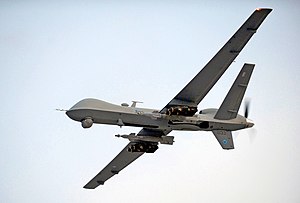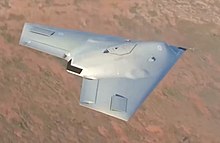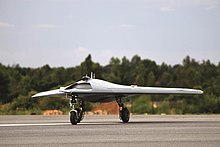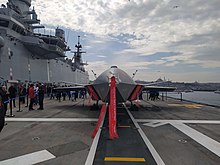
A | B | C | D | E | F | G | H | CH | I | J | K | L | M | N | O | P | Q | R | S | T | U | V | W | X | Y | Z | 0 | 1 | 2 | 3 | 4 | 5 | 6 | 7 | 8 | 9

An unmanned combat aerial vehicle (UCAV), also known as a combat drone, fighter drone or battlefield UAV, is an unmanned aerial vehicle (UAV) that is used for intelligence, surveillance, target acquisition, and reconnaissance and carries aircraft ordnance such as missiles, anti-tank guided missiles (ATGMs), and/or bombs in hardpoints for drone strikes.[1][2][3] These drones are usually under real-time human control, with varying levels of autonomy.[4] UCAVs are used for reconnaissance, attacking targets and returning to base; unlike kamikaze drones which are only made to explode on impact, or surveillance drones which are only for gathering intelligence.
Aircraft of this type have no onboard human pilot.[5] As the operator runs the vehicle from a remote terminal, equipment necessary for a human pilot is not needed, resulting in a lower weight and a smaller size than a manned aircraft. Many countries have operational domestic UCAVs, and many more have imported fighter drones or are in the process of developing them.[6]
History
One of the earliest explorations of the concept of the combat drone was by Lee De Forest, an early inventor of radio devices, and U. A. Sanabria, a TV engineer. They presented their idea in an article in a 1940 publication of Popular Mechanics.[7] The modern military drone as known today was the brainchild of John Stuart Foster Jr., a nuclear physicist Lawrence Radiation Laboratory).[8] In 1971, Foster was a model airplane hobbyist and had the idea this hobby could be applied to building weapons.[8] He drew up plans and by 1973 DARPA (Defense Advanced Research Projects Agency) built two prototypes called "Prairie" and "Calera". They were powered by a modified lawn-mower engine and could stay aloft for two hours while carrying a 28-pound (13 kg) load.[8]
In the 1973 Yom Kippur War, Israel used unarmed U.S. Ryan Firebee target drones to spur Egypt into firing its entire arsenal of anti-aircraft missiles.[9] This mission was accomplished with no injuries to Israeli pilots, who soon exploited the depleted Egyptian defences. In the late 1970s and 80s, Israel developed the Scout and the Pioneer, which represented a shift toward the lighter, glider-type model of UAV in use today. Israel pioneered the use of unmanned aerial vehicles (UAVs) for real-time surveillance, electronic warfare, and decoys.[10][11][12] The images and radar decoying provided by these UAVs helped Israel to completely neutralize the Syrian air defenses in Operation Mole Cricket 19 at the start of the 1982 Lebanon War, resulting in no pilots downed.[13]
In the late 1980s, Iran deployed a drone armed with six RPG-7 rounds in the Iran–Iraq War.[14]
Impressed by Israel's success, the US quickly acquired a number of UAVs, and its Hunter and Pioneer systems are direct derivatives of Israeli models. The first 'UAV war' was the first Persian Gulf War: according to a May 1991 Department of the Navy report: "At least one UAV was airborne at all times during Desert Storm." After the Persian Gulf War successfully demonstrated its utility, global militaries invested widely in the domestic development of combat UAVs.[15] The first "kill" by an American UAV was on October 7, 2001, in Kandahar.[16]
In recent years, the U.S. has increased its use of drone strikes against targets in foreign countries and elsewhere as part of the War on Terror. In January 2014, it was estimated that 2,400 people had died from U.S. drone strikes in five years.[17] In June 2015, the total death toll of U.S. drone strikes was estimated to exceed 6,000.[18]
In 2020, Turkey became the first country to use UCAVs in a large, coordinated attack on a conventional battlefield when they attacked forces in Syria. They were used to attack enemy positions, to provide cover for ground forces and to scout for artillery.[19] Drones were used extensively in the 2020 Nagorno-Karabakh war between Azerbaijan and Armenia.[20] Azerbaijan's use of cheaper Turkish TB2 drones was seen as crucial to their victory against the Armenian forces.[21] Drones were also used extensively during the 2022 Russian invasion of Ukraine.[22] Usage of drones offers a cost advantage: "People are taking small drones, like the ones you can buy at JB Hi-Fi for $2000, putting a grenade on them and flying them over a crowd or a tank and releasing the grenade. You can basically build a $3000 machine to destroy a $5 million piece of equipment that your enemy has."[23]
Current
Below are a list of some current dedicated armed UAV's:

Some reconnaissance drones that have armed capability include the CASC CH-92, IAI Eitan and the Ababil-3, Ababil-5, Hamaseh. Some commercial drones such as DJI Mavic and Phantom have been modified to carry light explosives for combat missions in recent wars.
Future
Below is a table of some technology demonstrators and projects in development:

| Aircraft | Country | Notes |
|---|---|---|
| AVIC Dark Sword | China | Technology demonstrator/testing |
| BAE Systems Corax | United Kingdom | Technology demonstrator |
| BAE Systems Taranis | United Kingdom | Technology demonstrator |
| Boeing Phantom Ray | United States | Under development/testing |
| Dassault nEUROn | European Union | Experimental stealth UCAV |
| DRDO Archer-NG | India | Under development |
| DRDO Ghatak | India | Under development/testing |
| Eurodrone | European Union | Under development |
| EMC Operations Anaconda | United Kingdom | Under development/testing |
| HAL CATS Warrior | India | Under development |
| Northrop Grumman X-47A | United States | Technology demonstrator inc. X-47B / C variants |
| Bayraktar Kızılelma | Turkey | Under development/testing |
| TAI Anka-3 | Turkey | Under development |
| Stella Tecnologia Atobá XR | Brazil | Under development |
| S-70 Okhotnik-B | Russia | Under development/testing |
| IAIO Qaher-313 | Iran | Under development/testing |
| Qods Mohajer-7 | Iran | Under development |
| Qods Mohajer-9 | Iran | Under development |

Israel
Elbit Hermes 450

The Israeli Air Force, which operates a squadron of Hermes 450s out of Palmachim Airbase south of Tel Aviv, has adapted the Hermes 450 for use as an assault UAV, reportedly equipping it with two Hellfire missiles or, according to various sources, two Rafael-made missiles. According to Israeli,[24] Palestinian, Lebanese, and independent reports, the Israeli assault UAV has been used in the Gaza Strip and was used intensively in the Second Lebanon War. Israel has not denied this capability, but to date, its policy has been to not officially confirm it either.[citation needed]
Turkey
TAI Aksungur
TAI Aksungur is a built by Turkish Aerospace Industries (TAI) for the Turkish Armed Forces.[25][26][27][28] Using existing technology from the TAI Anka series of drones, it is the manufacturer's largest drone,[29] with payload capacity for mission-specific equipment. It is intended to be used for long-term surveillance, signals intelligence, maritime patrol missions, or as an UCAV. The first unit was delivered to the Turkish Naval Forces on 20 October 2021.
Bayraktar Kizilelma

Bayraktar Kızılelma is a proposed jet-powered, single-engine, low-observable, supersonic, carrier-capable unmanned combat aircraft in development by Baykar, famous for its Bayraktar TB2. On 12 March 2022, Selçuk Bayraktar, CTO of Baykar announced that the first prototype of the Bayraktar Kızılelma has entered the production line.[33][34]
Zdroj:https://en.wikipedia.org?pojem=Unmanned_combat_air_vehicleText je dostupný za podmienok Creative Commons Attribution/Share-Alike License 3.0 Unported; prípadne za ďalších podmienok. Podrobnejšie informácie nájdete na stránke Podmienky použitia.
Antropológia
Aplikované vedy
Bibliometria
Dejiny vedy
Encyklopédie
Filozofia vedy
Forenzné vedy
Humanitné vedy
Knižničná veda
Kryogenika
Kryptológia
Kulturológia
Literárna veda
Medzidisciplinárne oblasti
Metódy kvantitatívnej analýzy
Metavedy
Metodika
Text je dostupný za podmienok Creative
Commons Attribution/Share-Alike License 3.0 Unported; prípadne za ďalších
podmienok.
Podrobnejšie informácie nájdete na stránke Podmienky
použitia.
www.astronomia.sk | www.biologia.sk | www.botanika.sk | www.dejiny.sk | www.economy.sk | www.elektrotechnika.sk | www.estetika.sk | www.farmakologia.sk | www.filozofia.sk | Fyzika | www.futurologia.sk | www.genetika.sk | www.chemia.sk | www.lingvistika.sk | www.politologia.sk | www.psychologia.sk | www.sexuologia.sk | www.sociologia.sk | www.veda.sk I www.zoologia.sk
